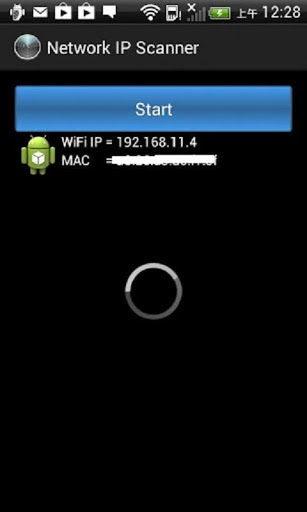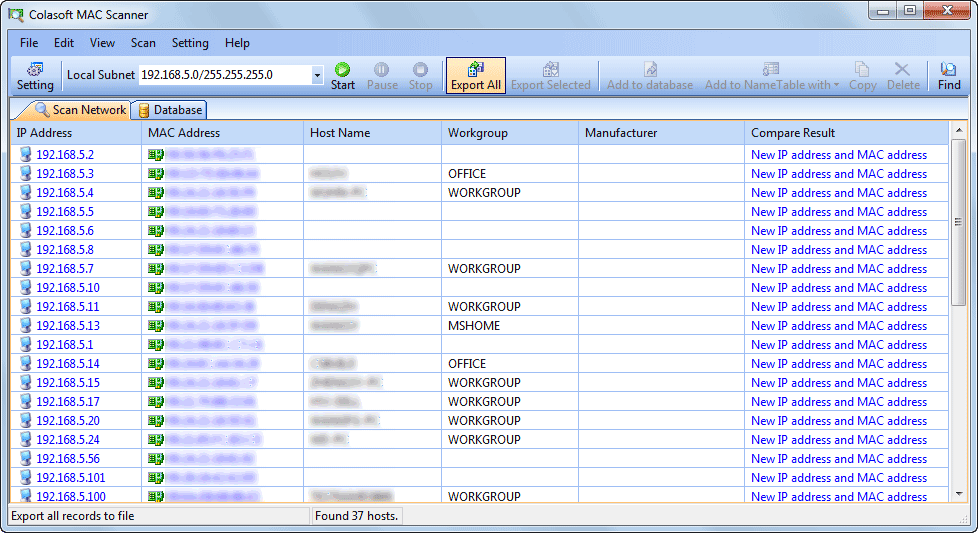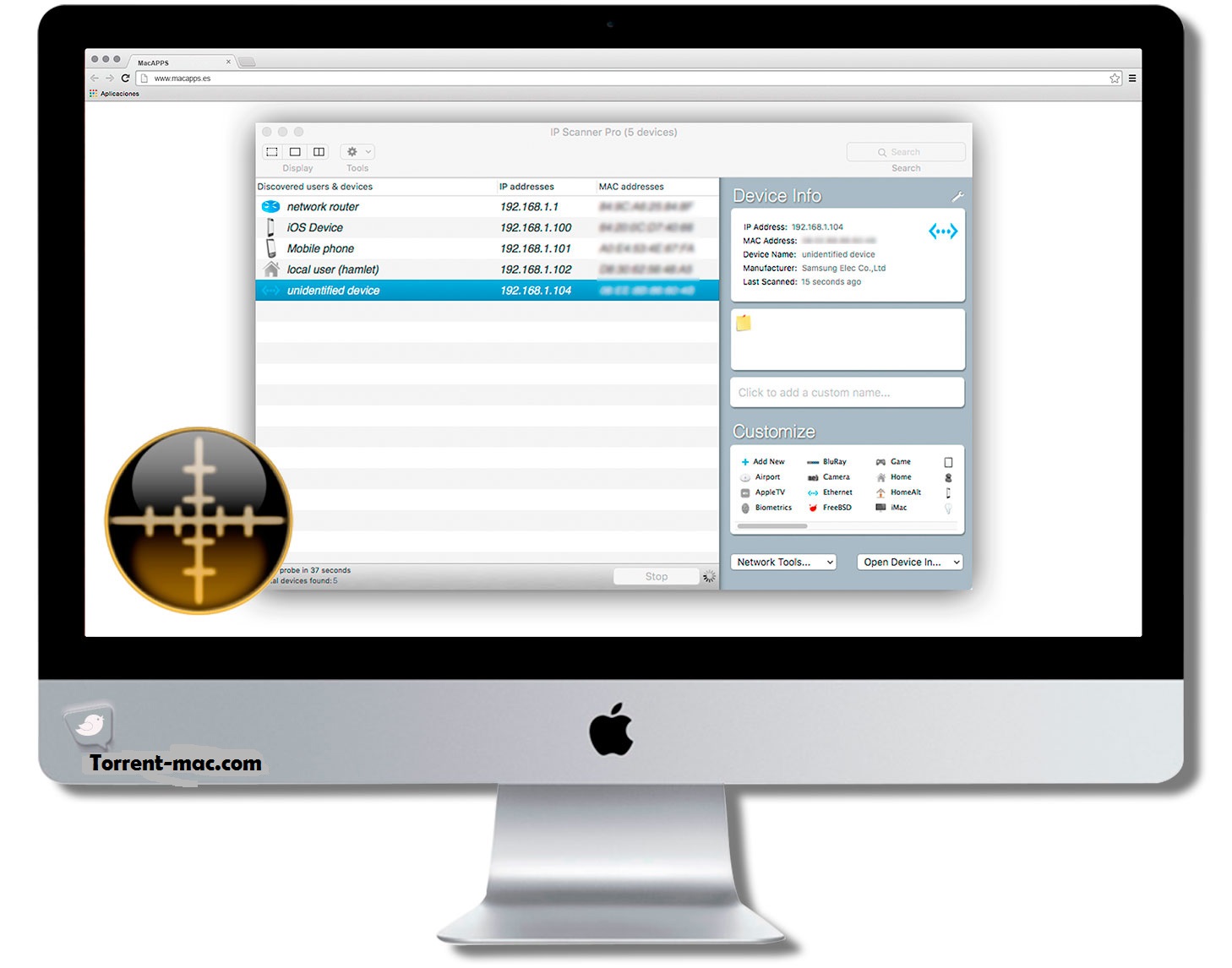The zip file contains Mac application bundle: just save it and double-click to extract. On first run right-click and select Open or go to Settings/Security and allow installing apps from other sources besides Mac Store. See FAQ entry for more info. You can then run it by double-clicking the Angry IP Scanner icon. Or drag it to the applications. Angry IP Scanner (or simply ipscan) is an open-source and cross-platform network scanner designed to be fast and simple to use. It scans IP addresses and ports as well as has many other features. It is widely used by network administrators and just curious users around the world, including large and small enterprises, banks, and government agencies.
| FastResolver v1.26 - Scan IP addresses for host names and MAC addresses Copyright (c) 2005 - 2014 Nir Sofer |
Related Utilities
- NetResView - View all computers/shares on your network.
- PingInfoView - Ping to multiple host names/IP addresses.
Description
FastResolver is a small utility that resolves multiple host names into IP addresses and vice versa.You can simply type the list of IP addresses or host name that you want to resolve, or alternatively, you can specify IP addresses range that you want to scan.For local network, FastResolver also allows you to get the MAC address of all IP addresses that you scan.FastResolver is a multithreaded application, so it can resolve dozens of addresses within a few seconds.Versions History
- Version 1.26:
- Added 'Copy As Hosts File' option. (Ctrl+H)
- Version 1.25:
- Added 'MAC Address Format' option (XX-XX-XX-XX-XX-XX, XX:XX:XX:XX:XX:XX, or XXXXXXXXXXXX).
- Version 1.23:
- Fixed to work with the latest versions of oui.txt
- Version 1.22:
- Fixed bug: The size of addresses list text-box was limited to 32 KB.
- Version 1.21:
- Added support for typing IP range, like 192.168.0.1-192.168.0.10
- Version 1.20:
- Added 'Company Name' column that is determined according to the MAC address (Requires to download externl file - see below)
- Version 1.16:
- Fixed bug: The main window lost the focus when the user switched to another application and then returned back to FastResolver.
- Version 1.15:
- Added support for starting the IP addresses scanning from command-line
- Added support for saving into comma-delimited (.csv) file.
- Fixed bug in radio buttons of mode selection
- Version 1.10:
- Added support for scanning MAC addresses (works only for local network).
- Added new option: Resolve hosts without domain.
- The configuration is now saved to a file, instead of the Registry.
- Version 1.00 - First release.
System Requirements
- Windows operating system: Windows 98/ME/2000/XP/2003.
- Network connection.
Be aware that resolving IP address to host name doesn't work well under Windows 98/ME.
Using FastResolver
FastResolver doesn't require any installation process or additional DLLs.Just put the executable file (FastResolver.exe) anywhere you like, and run it.
Angry Ip Scan For Mac
After you run FastResolver utility, you can type multiple IP addresses and host names, separated by commas, spaces, or CRLF.Alternatively, you can select IP addresses range to resolve into host names.Free Ip Scanner For Mac
The 'Company Name' Column
Starting from version 1.20, FastResolver allows you to view the company name of each MAC address.However, in order to get this feature, you must download the following external file, and put in the same folderof FastResolver.exe: http://standards-oui.ieee.org/oui/oui.txtBe aware that you must save it as 'oui.txt'
Options Menu
- Display Multiple Host IP Addresses: If this option is checked, and the host name has multiple IP addresses, all IP addressesare displayed.
- Resolve IP Addresses Back To Host Name:If this option is checked, and you resolve an host name to IP address, the IP Address is resolved back into a host name, and displayed in 'Host Name' column. The original host name that you typed is displayed under 'Original Name' column.
Command-Line Options

| /IPTo <IP Address> | Specifies the to IP address | |||||||||||||||||||||||||||||||||||||||||||||||||||||||||||||||||||||||||||||||||||||||||||||||||
| /DisplayMultiIPAddr <0 | 1> | Display Multiple Host IP Addresses. 1 to enable, 0 to disable. | |||||||||||||||||||||||||||||||||||||||||||||||||||||||||||||||||||||||||||||||||||||||||||||||||
If you want to run FastResolver without the translation, simply rename the language file, or move it to another folder. LicenseThis utility is released as freeware. You are allowed to freely distribute this utility via floppy disk, CD-ROM, Internet, or in any other way, as long as you don't charge anything for this. If you distribute this utility, you must include all files inthe distribution package, without any modification !Disclaimer The software is provided 'AS IS' without any warranty, either expressed or implied,including, but not limited to, the implied warranties of merchantability and fitnessfor a particular purpose. The author will not be liable for any special, incidental,consequential or indirect damages due to loss of data or any other reason. The software is provided 'AS IS' without any warranty, either expressed or implied,including, but not limited to, the implied warranties of merchantability and fitnessfor a particular purpose. The author will not be liable for any special, incidental,consequential or indirect damages due to loss of data or any other reason. FeedbackIf you have any problem, suggestion, comment, or you found a bug in my utility, you can send a message to nirsofer@yahoo.com
FastResolver is also available in other languages. In order to change the language of FastResolver, download the appropriate language zip file, extract the 'fastresolver_lng.ini', and put it in the same folder that you Installed FastResolver utility.
Network scanning is a necessary task, but it can start off simple and rapidly become more complicated as your business gets larger. Manually finding IP addresses on your network is possible, but why do it yourself when there are so many tools to help you? Not only can network scanning tools help you find IP addresses, but they can also provide extra information for monitoring, troubleshooting, and keeping your network running efficiently. My top choice for a network scanning tool is the SolarWinds® IP Address Manager, as it works in an intuitive and easy-to-use way while offering a broad suite of tools and functions. It’s more approachable than some of the other tools out there and has a flatter learning curve for figuring out how to get started. How to Find IP Addresses of Devices on My NetworkCurious how to find IP addresses on-network? You may need to know about either static or dynamic IP addresses. If you can access your router, you may be able to simply view the client lists and get information like hostname and MAC address. Or you can use a device connected to the network to ping the network and view the ARP tables. Done manually in this way, you have to do everything through the command line. Use the prompt “ipconfig” on Windows to get network settings, followed by “arp -a” to view IPs plus MAC addresses. However, this method doesn’t work across subnets. This means that if you have multiple subnets on your network, you have to go through each individual router or subnet to determine the IP addresses within the subnet. It becomes pretty clear as your network scales, manually scanning for IP addresses becomes an extremely complex task. Multiple subnets and an ever-changing string of devices connecting to and disconnecting from the network becomes problematic. Instead of attempting to manually manage these aspects of your network, I recommend using an IP address manager (IPAM). These tools help you to manage your IP addresses and troubleshoot problems, but they also help you to find all the IP addresses of the devices on your network and determine the status of each one (dynamic, static, available, reserved, etc.). Some tools will also integrate with DNS and DHCP, and all of them will usually present data in a visual, interactive format. Many also allow you to save your network scanning results and present them in spreadsheets or reports. Best Network Scanner Tools 2020 SolarWinds IP Address ManagerThis is my top choice for network scanning software. The SolarWinds IP Address Manager (IPAM) with its IP Address Scanner feature is great for both beginner users and small businesses, and expert network administrators and large enterprises. With automated IP address tracking and integrated DHCP and DNS management, you can quite easily monitor your IP addresses and associated network information. You can also see all your subnets and how they are structured, and which subnets and scopes don’t have much free space remaining. It allows you to flag capacity issues before they become a problem so that IP address issues don’t affect performance. I’ve also found it’s easy to find unused IPs and reclaim them to tidy up my networks. This IPAM uses a clean and simple interface, without a steep learning curve like some other IP address managers. You can easily assign management or control permissions to other admins or admin groups, allowing you to delegate tasks simply within the IPAM rather than needing to use another tool. The console is centralized, allowing you to see all the relevant information in one place, reducing the potential for error. I consider the SolarWinds IPAM to be a complete solution, and it’s my choice for an all-round lightweight tool you can use to scan and maintain your network. There’s a free trial available so you can try it out, then level up to gain access to more features and greater scalability. MyLanViewerThis is another strong business-level contender for network scanner tools. MyLanViewer is an IP and network scanner, as well as a traceroute tool and network monitor. It uses a buddy-list style window to display all of your network computers, including important technical information about each one. It can scan your network to monitor IPs and let you know when any details change. It also supports remote shutdown and other remote functions for each network computer. It can monitor hidden devices on your subnets and discover bottlenecks in your connection with its traceroute tool. I’d say this is a fine choice for business use—it has an easy-to-use interface and is suitable for beginners and advanced users. Angry IP ScannerLooking for one of the best free tools? This is an open-source and free network scanning tool, with the ability to scan ports and IP addresses quickly and efficiently. The tool provides a report of data on each device on the network, including NetBIOS, MAC and IP address, computer name, and hostname. Keep in mind that open-source tools do require a bit more know-how on the user’s part and aren’t my usual pick for business use. Angry IP Scanner can also produce reports in XML, CSV, and TXT format, which is useful for exporting data and other things within your business. Its unique feature is it uses a multi-threaded scanning approach, which uses a separate scanning thread for each IP address. This helps to improve the scanning process and make it more accurate. Picking the Best IP ScannerWhen I want to discover IP addresses on my network or scan for data generally, I tend to lean toward using a network scanning tool rather than trying to do it manually. Many network scanners have simple interfaces, and some go above and beyond in terms of ease-of-use and clean interface appearance. I like using the SolarWinds IP Address Manager, as it contains a pretty hefty solution in a lightweight package, with a free trial for people who want to try it out without commitment. Recommended Reading Ultimate Guide to Network Monitoring: If you’re looking for more in-depth information on how to monitor and look after your network, take a look here for a beginner’s guide followed by more expert-level instructions.  Comments are closed. |